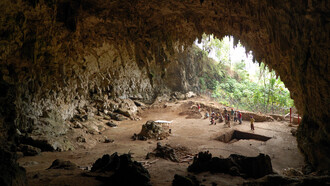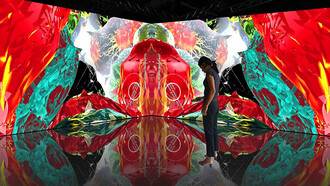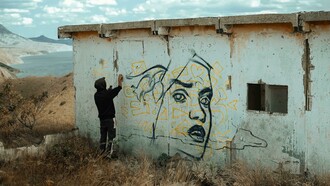While visiting Burgundy and enjoying its fine wines, I came across a wonderful retrospective exhibition in the medieval town of Avallon by a French painter whose work I immediately wanted to explore. The ancient inner walls of various buildings had been filled with his intensely colored natural landscapes made over a forty year period. This turned out to be the first retrospective in France of the artistic career of Michel Couchat (1935-1998).
To my surprise, Couchat was one of a host of French painters whose exceptional talents were never sufficiently recognized during their lifetime. Michel, who was something of a prodigy, had his first solo exhibition at he age of 19 at the Galerie de l’Odeon in Paris and altogether had some 98 shows in five countries during his lifetime. His artistic trajectory was focused on by this show, examining how Couchat made contact with the earth, its rocks, trees, fields and seasons - in sum with our planet. His episodes of periodic euphoria and depression became immediately evident in the colorations of the works exposed in this, to me, highly enticing display.
Couchat painted against the artistic currents in France which swept by during his career. He rejected the minimalist, conceptualist and other fashionable modes in order to integrate the expressionist colors and emotional variations he so admired in both Cezanne and Van Gogh. Early on, he crafted his own mood fluctuations into an inimitable flamboyant style. With daring, he used shades of sweeping blues to boldly paint trees, which combined his spirit with that of the breathing trees.
In his thirties Couchat bought a small house in Fayence, in Provence, not far from the landscapes which had inspired his hero, Cezanne. During the entire course of his life Couchat was to be inspired by the ancient olive groves around this house. He painted them with love and persistence, focusing at first on their trunks, which had been trimmed and “manicured” for generations. This relationship only came to a tragic end when a terrifying brush fire swept through the area destroying the entire grove overnight. Couchat emotionally conveyed his mourning in dramatic paintings of the blackened stubs and ashes amidst a background of fiery reds from the scorching flames.
Couchat identified closely with the long struggle for survival of these olives in their harsh and threatened environment with his own struggle for physical survival in the art world. Personally, he had been on a plane of higher spiritual aspirations. In his fifties he had planned to paint a formation of these olive trees on a vast canvas of Agony in the Garden, but abandoned this project as too overwhelming. Ultimately it was in the life of trees that Couchat revealed himself most intimately. He seldom painted the face of human beings, with only a few examples of his wife or three devoted daughters existing. However, he found the challenge of his own self-portrait captivating. He made numerous sketches portraying a smile, a frown, or a look in the mirror, which convey a sense of the intensity of his efforts to capture a particular moment. Couchat himself wrote later on in his life:
“Subjective, dramatic, psychological elements creep into the work, stealthily, in spite of oneself, almost without one’s knowing it, according to our temperament, bringing out the real presence and vital essence of being human.”
Couchat struggled to transpose on paper and canvas his visions of the inner and outer worlds as well as the connections between them. This was most evident in these self-portraits, which reflected his desire to combine the two. Projecting such feeling in painting the rocks around Fayence with their pale, crusty textures, where the ochre oils were mixed with the sand of the rocks themselves, was an equally personal challenge, an early painting of rocks done with dabs, spots and patches of subtle color and light modulations won him the prestigious Prix Feneon competition. The way he portrayed the shifting perspective of the rocks close up with the hardly visible portrayals of the distant stone homes of the city was truly engaging. The intense white light in which he painted had almost bleached out all the contours.
Couchat loved to go out into the countryside with an easel on his back, exuding the good scent of turpentine. He wrote about such outings; “My focus was on the relationship of mass in nature, on its movements: the topology of the land, the feeling of being very close to what is real, of being one with nature, of grasping the space almost physically. “ For him it was like moving towards an abstract landscape.
When Couchat returned to Paris every autumn after a summer spent in the open spaces, he felt trapped by the urban concrete jungle. This forced him repeatedly to move towards ever changing aspects of objectification. The Parisian, working class neighborhood of Pantin where the city had given him a large top floor studio, brought on frequent depressions. The poverty of the often rubbish strewn streets, the grey Parisian winter skies and the colorless tenements deeply affected his work. Towards the end of his life he tried to dispel these dark clouds by painting colorful spectacles and celebrations, which he remembered from each summer. He portrayed costumed couples dancing to the music of a band, rhythm and harmony weaving magically on canvas to create the aura of a symphonic festival. To Couchat this was a way to put the metallic and grinding music of the neighboring tin cans and the rattle of the shanty-towns out of his mind.
Friends say that he enjoyed red wine and the company of other artists like Max Ernst, Jean Helion and Cesar Silvagni, but felt uncomfortable with art dealers, curators and museum bureaucrats. He frequently visited friends in Cambridge, England, and was inspired to paint the low horizons of its flat fields. The ever-changing skies over plowed hectares prompted him to shift the autumnal colors with variations not only for the seasons but also with the time of day. The critic Mary-Rose Beaumont wrote that Couchat was heir to the great French tradition of landscape painting- following the footsteps of the impressionists. He eagerly adapted and invigorated various experiments on the broken brushwork techniques of Claude Monet.
Couchat also produced a series of paintings of a great cedar tree in Cambridge whose power he found overwhelming. The different aspects of its embracing branches reflected his own vacillating moods: Sometimes its grooved trunk was dark and gloomy at other times the arms were vibrant and bursting with the prodigious strength of life itself. A couple of these cedar paintings were threatening, yet noble; others were protective and enhancing. Couchat’s exceptional eye and romantic sensibilities enabled him to convey the transfer of some of his human qualities unto the awesome cedar. On canvas, these interpretations of nature, which sometimes conveyed strength as well as frailties, mark Couchat’s exceptional talents. The artist himself wrote:
“The work of observing and understanding the space as well as of meaningful separations develops our visual sharpness and heightens it. The seemingly passive contemplation of appearances does not lead to hyper-realism or trompe l’oeil, but rejects all forms of mannerism.”
In his lifetime art critics in France were never able to apply a label to his works, as Couchat did not meet the usual criteria, which drive the currents in the art market. It was all too easy for the media to marginalize him for describing the world in the truthful way he did. Patrick Walberg wrote that Couchat was not about reproducing the taut curve of a nude or the subtle structure of a face as objects. He was intent on capturing a moment of one’s soul through them.
Towards the end of his life, when he was already suffering from lung cancer, he painted a series of fantasized tumuli, which he declared to be monuments to vanished friends. Most of these burial mounds were in darker, somber colors set against backgrounds of differing bluish and purplish skies. The divided colors seem to have reflected his own changing moods. The sweeping brush strokes of these bulky monumental graves for homo sapiens were truly landscapes originating in his mind: Painted predictions of what was to come.
“Ultimately it is in landscapes that his true genius lies,” wrote Mary Rose Beaumont. “He portrays the grandeur of a landscape in all its moods, smothering with anger when brush fires were burning, dark, fierce and passionate, painted with energy and speed, or a serene pastoral in the calm light of the evening.” The variety of Couchat’s works, so skillfully presented by his daughters Domitille and Fanny in the retrospective in Avallon, testified that as a painter Couchat should be rated very highly in the temple of the visual arts.















